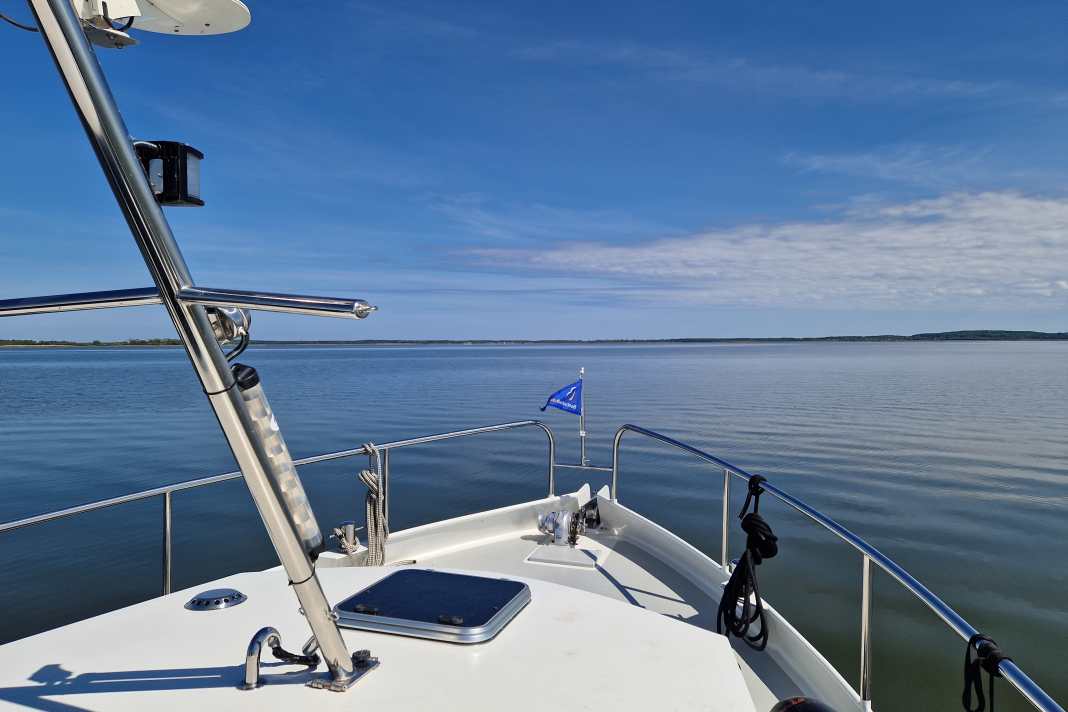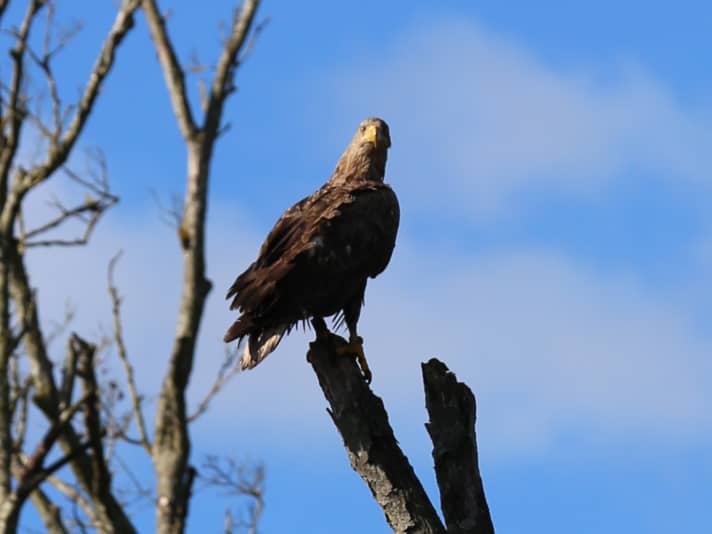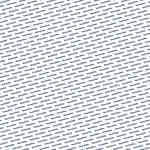Voyage: Peenestrom and Achterwasser - heading for the sunny island of Usedom
Jill Grigoleit
· 02.11.2025






We have 46 kilometres and no bridges ahead of us to Anklam. With no time pressure, we set off on what is perhaps the most beautiful section of the Peene. At first, we cycle past yellow rapeseed fields under a blue sky. But just a few kilometres after Loitz, we cycle through unspoilt countryside as far as the eye can see. The sun glistens on the widening river. The wind turbines on the horizon are the only visible signs of human civilisation. Where else in Germany is there anything like this?

We drive through eagle territory
We drive through a section of forest - eagle territory. It feels like one of these noble creatures sits on every second tree and looks down at us with an accusing stare. All the dead wood on the banks looks spooky. But what looks sick at first glance is actually a sign of an intact ecosystem in which nature can develop freely. After decades of intensive agriculture had severely drained and damaged the marshy river course, polders were flooded and bogs rewetted as part of one of Germany's largest nature conservation projects. As a result, deadwood biotopes remain as an important habitat.
Pure idyll in Stolpe
We pass the Stolpe water hiking rest area at river kilometre 79.5, where we will stop for the night on our way back. Of all the stops, this lovingly redesigned little harbour is by far the most beautiful. In addition to the 28 berths (on finger pontoons), the two friendly harbour masters run a small snack bar with idyllic outdoor seating and a small grocery shop. (harbourstolpe.com) If you're looking for seclusion, this is the place for you. Apart from the reed warbler and the cuckoo in the nearby riverside forest, we hear nothing. We don't meet a soul on our walk through the village. There is even an interesting exhibition centre here, the Nature Park Centre. And an inn steeped in history: the "Stolper Fährkrug" right next to the marina is one of the oldest pubs still in operation in Western Pomerania. "Until 300 years ago, the Peene was the border river to Sweden - and the 'Stolper Fährkrug' is another 50 years older," says the website (gutshaus-stolpe.de/stolper-faehrkrug).
Anklam: City of the aviation pioneer
After three hours of pure nature, we catch sight of the church towers of Anklam, visible from afar in the flat landscape. As we head for the longside mooring of the water hiking rest area, the friendly harbour master arrives to take the lines. And this despite the fact that his snack terrace is well frequented on this sunny Sunday afternoon. Fish sandwiches, smoked fish, beer and cocktails not only attract water sports tourists and campers, locals also come here for a sundowner on the banks of the Peene. Rainer Janke took over the waterside rest area a few years ago and, in addition to the mooring hire and snack bar, also runs a boat hire service (water hiking rest area-anklam.de). Many tourists visit the town, which along with Wolgast is also known as the gateway to the island of Usedom, when travelling through. The Hanseatic city is known as the birthplace of aviation pioneer Otto Lilienthal, to whom a museum is dedicated here. In the permanent exhibition, replicas of his gliders hang from the ceiling and his aerodynamic experimental set-ups encourage visitors to try them out (lilienthal-museum.de). Under the title "Ikareum", the city is currently pursuing the project to relocate the museum to Otto Lilienthal's baptismal church, the Nikolaikirche, and expand it into a museum and experience centre. The banks of the Peene are also to be further developed for tourist use. A "lagoon city with extended water sports facilities" is to be created.
On the Peenestrom and Achterwasser: SBF See!
The next day, we cast off ten minutes before the bridge opens. This is easy to time so close to the bridge. Please note: a telephone request is also necessary within the time slots! With the Anklam railway bridge, we pass the last hurdle on our way to the Baltic Sea. With a clearance height of five metres when closed, the Zecherin bridge is no obstacle for us. The famous blue steel structure, which connects the mainland with the island of Usedom, comes into view on the left as soon as we leave the Peene at kilometre 98 and head out onto the Peenestrom. With a strong headwind from the north-east, we enter the Peenestrom. From here, we have to keep strictly to the buoy line. According to the nautical chart, the two-metre limit is directly to the left and right of the very narrow channel. However, the buoys are so close together that it is almost impossible to stray from the path.
The steel displacer pounds against the churning water. A contrasting programme to the gentle gliding of the previous days. In the far south of Lieper Winkel, a peninsula between the Peenestrom and Achterwasser, lies the small harbour of Rankwitz, where we intend to spend the night. It's worth having bikes on board to explore the surrounding area. But you can also find everything you need in the well-equipped harbour: The holiday apartment complex includes a catering pavilion serving fish sandwiches and cakes. There is also a small village shop and a fish smokehouse - where we can pay our mooring fee at the fish counter outside of the harbour office opening hours - and a good restaurant with regional and seasonal specialities. In our case: fresh fish and asparagus. Afterwards, we head to the foredeck parked towards the sunset for an after-work drink. There are also pits with stern piles opposite the longside berths on the quay and, in the summer months, floating jetties in front of the harbour basin. However, when the wind picks up from the west-north-west, there is heavy swell (harbour-rankwitz.com).
Destination for the day: Baltic Sea beach!
The next day promises to be sunny. Perfect for the beach. We enter the Achterwasser from Lassan. Here, the Peenestrom forms a lagoon that extends so far into the island of Usedom that it is only separated from the Baltic Sea by a 300 metre narrow spit at Zinnowitz. That is our destination! We can literally smell the sea. So we wind our way along the "Hohe Schaar Süd" and "Warther Haken West" cardinal buoys, round the small island of Görmitz and set course for the Zinnowitz marina. The water level is so low that it takes a lot of climbing to get onto the quay wall via the folded-up bathing ladder. On the way to the beach, we pass impressive villas in seaside resort architecture on our way to the seafront promenade and the pier with its diving bell. Here we are far removed from the peace and seclusion we have enjoyed over the last few days. Instead of green reeds, a fine sandy beach attracts tourists in droves, instead of chirping crickets we hear children's laughter and screeching seagulls. Also beautiful. Only different. We sit down on the beach with chips and ice cream and dig our bare feet into the sand for the first time this year. And enjoy the comforts of civilisation for the moment. Before we head back tomorrow - into the wilderness of the Amazon of the north.
Precinct information
Charter: Yachtcharter Schulz, based in Waren an der Müritz, operates a network of bases in Waren, Röbel, Granzow, Neukalen, Barth and Kröslin, covering five areas between Berlin, the Mecklenburg Lake District and the Baltic Sea. The fleet consists of around 170 houseboats and motor yachts up to 15 metres in length, accommodating up to 12 people. Many of the boats and areas can be sailed without a pleasure craft licence. Contact: www.charter-schulz.de An der Reeck 1a, 17192 Waren (Müritz) Tel.: 03991/12 14 15
Boat: The Gruno 37 Excellent offers space for four people in two double cabins. Length: 11.30 metres, width: 3.75 metres. Equipment: Galley with multi-burner hob, refrigerator, a wet room with washbasin, WC and shower, another WC with washbasin and separate shower, heating, outside steering position under completely lockable tarpaulin with seating area, bow and stern thruster
Precinct: To operate a boat on the Peenestrom and Achterwasser rivers, you need an inland navigation licence and a sea navigation licence. There are no traffic jams, weirs or locks along the Peene. However, the opening times of the three bascule bridges in Demmin, Loitz and Anklam must be taken into account when planning your trip. As almost the entire length of the Peene Valley is a nature reserve, there are considerable restrictions on navigating the oxbow lakes and peat bogs as well as entering the shore areas: 99 per cent are closed. There are few marinas. Some waterway rest areas are equipped with moorings for smaller boats. On the Peenestrom and Achterwasser, you must strictly adhere to the fairway buoyage.
Literature: Kartenwerft Binnenkarten Atlas 1: Oder und Haff mit Peene - 2025, 49.90 euros, ISBN 9783944082493, www.hansenautic.de NV Gewässerkarten Binnen Atlas 3 - Nördliche Oder und Peene, 44.99 euros, ISBN 9783910644793, www.nvcharts.com

